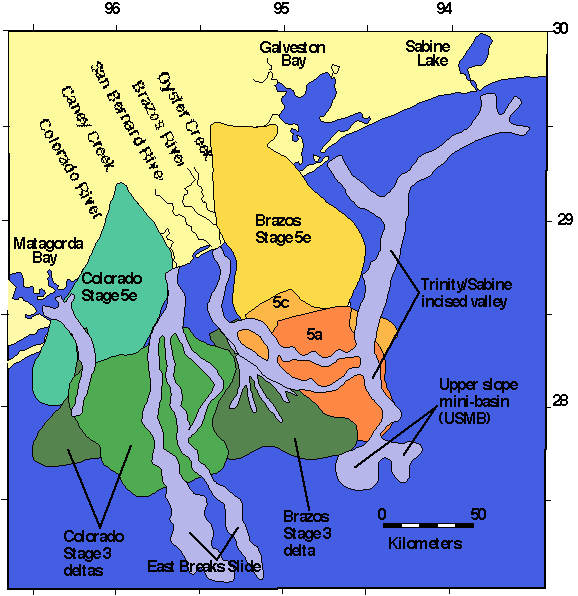East Texas (Brazos/Colorado)
Highstand Systems Tract
The HST of the east Texas: Brazos/Colorado region is separated into two
distinct stages (early and late) based on depositional style. During the
early stage the bedload-dominated Colorado River formed a lobate sandy delta.
In contrast, the suspended load-dominated Brazos River deposited an elongate
muddy delta. Three phases of growth, followed by backstepping
events, are recognized within the Brazos delta and these have tentatively
correlated to fith-order eustatic fluctuations during Stage 5
(Abdulah, 1995; 1996 ISG Report). Seismic facies and platform boring descriptions
show that these elongate delta lobes are comprised dominantly of silt and
clay.

During the late highstand, sea-level fell to an outer shelf location, except
for a brief period during Stage 3. During this time interval,
the Brazos and Colorado rivers constructed more typical birds foot-type,
fluvial-dominated deltas with branching distributaries and distributary
mouth bars. These younger deltas have onlapping relationships
with the older early highstand deltas. There are no platform borings through
these distributary channels and mouth bar facies, but their seismic character
implies an abundance of sand. We believe that the dramatic change in the
style of delta evolution may have resulted from a climatic change (increased
precipitation and associated fluvial and sediment discharge) in the drainage
basins of these rivers, which includes virtually all of west Texas. It is
also probable that the rate of sea-level fall decreased during the time
these fluvial-dominated deltas formed (the Stage 2 to Stage 3 transition, although better chronostratigraphic control is required to document
this change. The topset beds of the late highstand deltas have been removed
by ravinement processes from a subsequent rise in sea level.

Comments, questions? Contact us at
gulf@gulf.rice.edu.


